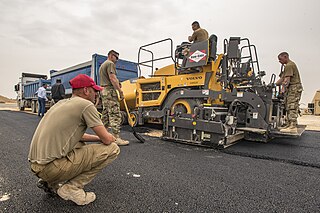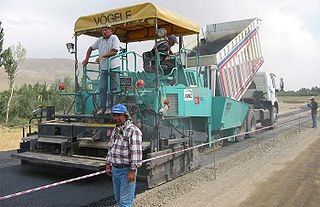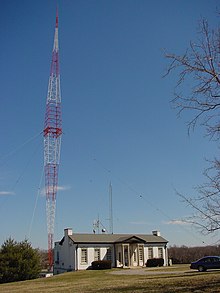Bobcat Company is an American-based manufacturer of farm and construction equipment. Its American headquarters is in West Fargo, North Dakota, formerly in Gwinner, North Dakota. Its European headquarters moved in 2017 from Waterloo, Belgium, to Dobříš, Czech Republic. It was a subsidiary of the Ingersoll Rand Company from 1995 until July 2007, when it was sold for US$4.9 billion to Doosan Infracore.

A road surface or pavement is the durable surface material laid down on an area intended to sustain vehicular or foot traffic, such as a road or walkway. In the past, gravel road surfaces, macadam, hoggin, cobblestone and granite setts were extensively used, but these have mostly been replaced by asphalt or concrete laid on a compacted base course. Asphalt mixtures have been used in pavement construction since the beginning of the 20th century and are of two types: metalled (hard-surfaced) and unmetalled roads. Metalled roadways are made to sustain vehicular load and so are usually made on frequently used roads. Unmetalled roads, also known as gravel roads, are rough and can sustain less weight. Road surfaces are frequently marked to guide traffic.

Asphalt concrete is a composite material commonly used to surface roads, parking lots, airports, and the core of embankment dams. Asphalt mixtures have been used in pavement construction since the beginning of the twentieth century. It consists of mineral aggregate bound together with bitumen, laid in layers, and compacted.

The free floating screed is a device pioneered in the 1930s that revolutionized the asphalt paving process. The device is designed to spread and smooth out, or screed, the material below it.

Heavy equipment, heavy machinery, heavy vehicles, earthmovers, construction equipment, construction machinery or construction vehicles, refers to heavy-duty vehicles specially designed to execute construction tasks, most frequently involving earthwork operations or other large construction tasks. Heavy equipment usually comprises five equipment systems: the implement, traction, structure, power train, and control/information.

Permeable paving surfaces are made of either a porous material that enables stormwater to flow through it or nonporous blocks spaced so that water can flow between the gaps. Permeable paving can also include a variety of surfacing techniques for roads, parking lots, and pedestrian walkways. Permeable pavement surfaces may be composed of; pervious concrete, porous asphalt, paving stones, or interlocking pavers. Unlike traditional impervious paving materials such as concrete and asphalt, permeable paving systems allow stormwater to percolate and infiltrate through the pavement and into the aggregate layers and/or soil below. In addition to reducing surface runoff, permeable paving systems can trap suspended solids, thereby filtering pollutants from stormwater.

Volvo Construction Equipment - Volvo CE - is a major international company which develops, manufactures, and markets equipment for construction and related industries. It is a subsidiary and business of the Volvo Group.
Pavement, in construction, is an outdoor floor or superficial surface covering. Paving materials include asphalt, concrete, stones such as flagstone, cobblestone, and setts, artificial stone, bricks, tiles, and sometimes wood. In landscape architecture, pavements are part of the hardscape and are used on sidewalks, road surfaces, patios, courtyards, etc.

A road roller is a compactor-type engineering vehicle used to compact soil, gravel, concrete, or asphalt in the construction of roads and foundations. Similar rollers are used also at landfills or in agriculture.

A paver is a piece of construction equipment used to lay asphalt concrete or Portland cement concrete on roads, bridges, parking lots and other such places. It lays the material flat and provides minor compaction. This is typically followed by final compaction by a road roller.

Construction aggregate, or simply aggregate, is a broad category of coarse- to medium-grained particulate material used in construction, including sand, gravel, crushed stone, slag, recycled concrete and geosynthetic aggregates. Aggregates are the most mined materials in the world. Aggregates are a component of composite materials such as concrete and asphalt; the aggregate serves as reinforcement to add strength to the overall composite material. Due to the relatively high hydraulic conductivity value as compared to most soils, aggregates are widely used in drainage applications such as foundation and French drains, septic drain fields, retaining wall drains, and roadside edge drains. Aggregates are also used as base material under foundations, roads, and railroads. In other words, aggregates are used as a stable foundation or road/rail base with predictable, uniform properties, or as a low-cost extender that binds with more expensive cement or asphalt to form concrete. Although most kinds of aggregate require a form of binding agent, there are types of self-binding aggregate which do not require any form of binding agent.

Terex Corporation is an American worldwide manufacturer of lifting and material-handling plant for a variety of industries including construction, infrastructure, quarrying, recycling, energy, mining, shipping, transportation, refining, and utilities. The company's major business segments include heavy machinery support for construction etc.

The Miller Group is a diverse transportation construction company based in Markham, Ontario, Canada where its Corporate Head Office is located. Its U.S. headquarters is located in Morrow, Georgia.
Clark Equipment Company was an American designer, manufacturer, and seller of industrial and construction machinery and equipment.
Ingersoll Rand is an American multinational company that provides flow creation and industrial products. The company was formed in February 2020 through the spinoff of the industrial segment of Ingersoll-Rand plc and its merger with Gardner Denver. Its products are sold under more than 40 brands across all major global markets.
Trane Technologies plc is a manufacturing company focused on heating, ventilation, and air conditioning (HVAC) and refrigeration systems. The company traces its corporate history back more than 150 years and was created after a series of mergers and spin-offs. In 2008, HVAC manufacturer Trane was acquired by Ingersoll Rand, a US industrial tools manufacturer. In 2020, the tools business was spun off as Ingersoll Rand and the remaining company was renamed Trane Technologies.
Soil stabilizers and road recyclers are engineering vehicles that were once similar machines; however, they are now specialised pieces of road making machinery and have developed into different machines. Other terms that are sometimes used are: road profiler, road reclaimer, road miller, road planer and pavement profiler. They are used in the process of full depth recycling.

Barber-Greene Company was a company founded in 1916 by American mechanical engineers Harry H. Barber and William B. Greene. It was formed to sell standardized material-handling machines to mechanize small manual tasks in an economical way. Though the company began by offering conveyors and bucket loaders, it is best known for its contributions to the asphalt field. In 1959, the company went public and was sold to Astec in 1986.
CMI Roadbuilding, Inc. of Oklahoma City began in 1961, when engineers headed by Bill Swisher started looking for new methods in the road building industry. Little had changed since the early 1900s in the methods of building roads, however, labor costs were skyrocketing and inflation meant taxpayers dollars were buying less and less. In the same period Society was becoming increasingly more mobile creating demand for better roads and highways. The CMI group believed that many road failures were due to poor riding surface which was mainly caused by inaccuracies in the subgrade.
Wirtgen Group is an internationally operating German company in the construction industry. The company's core business is the development and production of machinery for road construction and maintenance.













